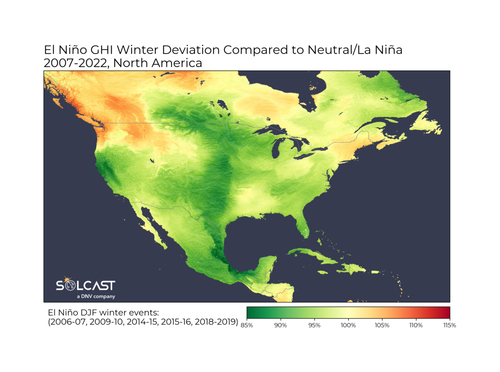El Nino Threat Puts US Solar Power Output At Risk This Winter
The Biden administration’s rapid push to decarbonize power grids with solar and wind while squeezing fossil fuel plants into early retirement could spark grid stability risks this winter as a new report sheds light on the possibility of “below average irradiance across most of North America” due to the impacts of El Niño producing more cloud coverage.
Solar-focused news publication PV Magazine said, “Solcast, a DNV company, predicts that El Niño will likely bring lower than normal solar power production through winter in the United States. Its analysis is based on data collected from previous El Niño events.”
El Niño threatens US winter solar generation: In a new weekly update for pv magazine, Solcast, a DNV company, predicts that El Niño will likely bring lower than normal solar power production through winter in… #renewableenergy #solarenergy #sustainability https://t.co/C4fI1F0sis pic.twitter.com/dyAgaG1DAT
— pv magazine (@pvmagazine) August 25, 2023
Here’s more from the report:
This coming winter is more likely than not to see below average irradiance across most of North America, as the impacts of El Niño bring cloudier, wetter conditions across the continent. Analysis of Historical Time Series data from El Niño years using the Solcast API, shows that irradiance is significantly impacted in these years.
The National Oceanographic and Atmospheric Administration (NOAA) has declared that we are in El Niño’s Southern Oscillation (ENSO) phase, and that there is a 90-95% probability this will continue into the upcoming winter.
NOAA has further forecast a 60% chance that this will be a “strong event,” so solar producers across the continent should be anticipating this to change their expected performance through the winter.
Analysis of December-February months from previous El Niño events (2006-07, 2009-10, 2014-15, 2015-16 and 2018-19) shows the historic impact on global Horizontal Irradiance (GHI). This image shows a comparison of the average GHI in the El Niño episodes with the neutral and La Niña phases of the ENSO climate cycle.
The clear observation is that most of the Continental US experienced reduced irradiance during El Niño winters. California, the Midwest, Southern states, and Mexico in particular see higher precipitation, as well as cloudier conditions.
Conversely, the North-eastern USA and neighboring Canadian provinces depict the opposite. These regions experienced increased irradiance during El Niño intervals.
This trend correlates with decreased precipitation during such periods, another trend these regions might expect in the coming winter.
As the solar energy sector leads into the lower-producing winter months, El Niño is likely to bring even lower than normal production through winter. The increased rain may result in decreased dust soiling for panels that aren’t already being cleaned regularly.
Numerous power grids across the US have warned about the growth of power demand, while decarbonization policies have led to a mismatch between power sources due to the early retirement of fossil fuel power generation. We’ve pointed this out in America’s Largest Power Grid Faces Worsening Reliability Risks and A Crisis Is Looming For The US Energy Grid.
Solar and wind are unreliable; these power sources are useless if the sun doesn’t shine or the wind doesn’t blow.
Meanwhile, a soaring number of Americans want reliable and clean nuclear power…
Tyler Durden
Sat, 08/26/2023 – 15:00
via ZeroHedge News https://ift.tt/uMY3FHp Tyler Durden
